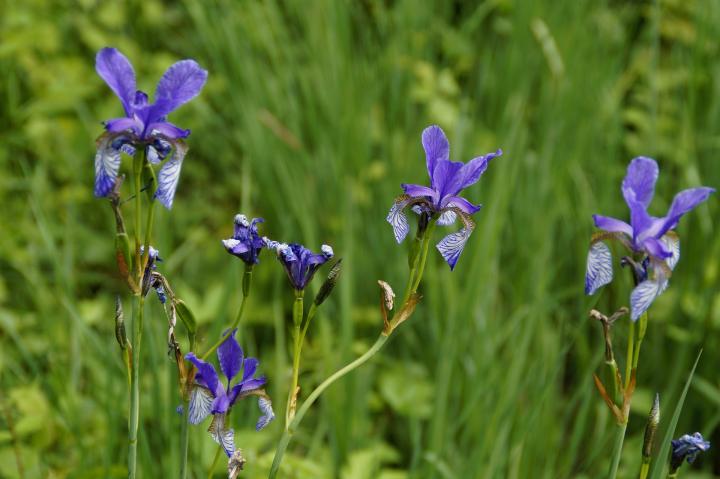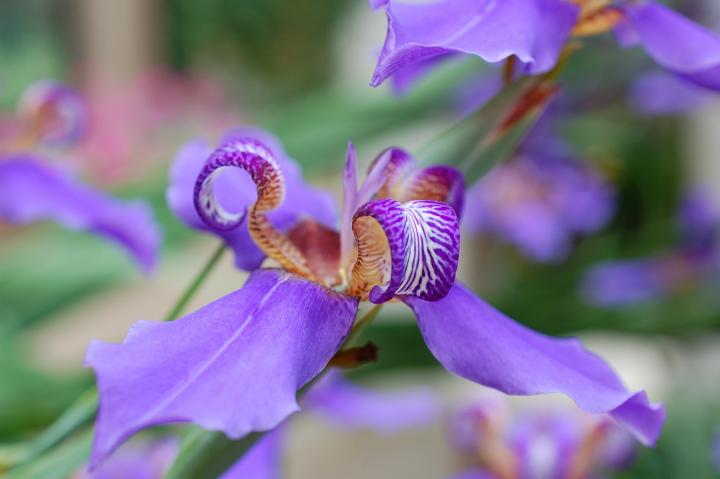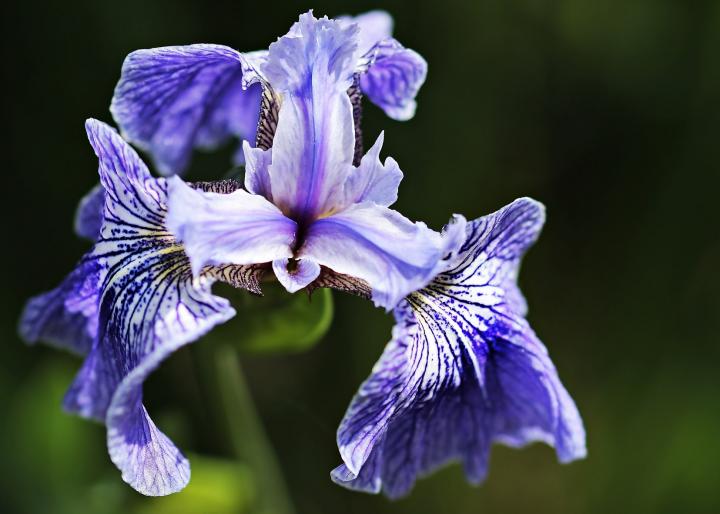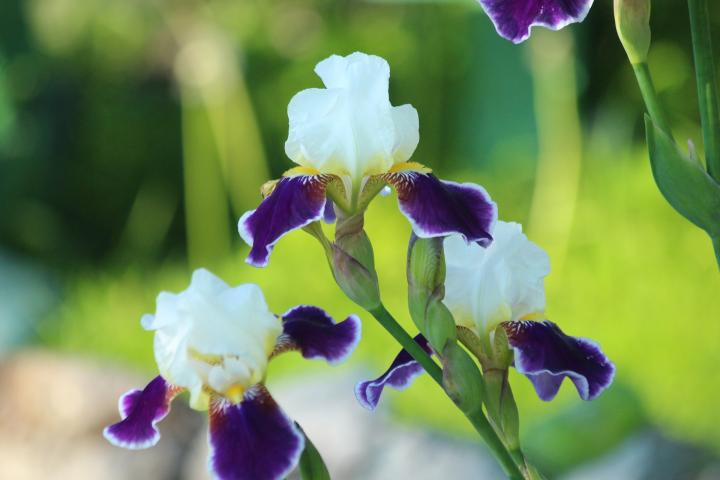| Aphids | Insect | Misshapen/yellow leaves; distorted flowers; leaf drop; sticky “honeydew” (excretion) on leaves; sooty, black mold | Knock off with water spray; apply insecticidal soap; inspect new plants carefully; use slow-release fertilizers; avoid excess nitrogen; encourage lacewings, lady beetles/bugs, spiders |
|---|
| Bacterial soft rot of iris | Bacteria | Dieback starts at leaf tips; leaves yellow/ wilt/separate from base; rhizomes rot; foul odor; plants may die | Cut out diseased rhizome tissue/air-dry cut surfaces for 1 to 2 days before replanting; for severe infections, destroy plants/surrounding
soil (do not compost); remove plant debris regularly; disinfect tools; good air circulation; prevent plant injury; control iris borers; plant rhizomes at proper depth |
|---|
| Blight (southern), “white mold” | Fungus | Leaves/stems/ entire plants wilt,
brown or blacken, and may die; water-soaked lesions on lower stems; crown/rhizome
rot; fluffy, white fungal mats with mustard- seed–like balls on stems bases/nearby soil | Destroy infected parts/ plants (if severe), white fungal mats, and surrounding soil to at least 6 inches beyond plant and 8 inches deep (do not compost); remove plant debris regularly; disinfect tools; solarize soil; resistant varieties; good drainage |
|---|
| Blight (Botrytis), “gray mold” | Fungus | Yellow/ brown/gray spots with water-soaked margins on leaves/flowers; gray mold; buds remain closed; stem lesions; wilt/rot; scorched appearance (“fire”) in some plants | Destroy infected parts/ severely infected plants (do not compost); remove plant debris regularly; disinfect tools; good air circulation/ sunlight; avoid overhead watering; prevent plant stress/injury; weed; rotation |
|---|
| Ink spot | Fungus | Yellow-margined, reddish brown leaf spots; brownish black powdery mass in spots; plants collapse; inky black stains on some rhizomes; rhizomes rot | Destroy infected leaves/rhizomes (do not compost); remove plant debris regularly; good air circulation; 3-year rotation |
|---|
| Iris borers | Insect | Leaf tips turn brown; pinholes chewed in leaves (caterpillar/larvae entry); holes bored in rhizomes; slimy, stinky mess at plant base and rhizome | Squash by hand or remove and discard affected foliage before pupation (and new moths, mating, eggs); inspect suspected rhizome damage, discard (burn/bury) affected ones; clean beds of plant debris after a hard frost |
|---|
| Iris weevils (“flag weevils”) | Insect | Beetle-like insects feed on flowers, seeds, pods of wild blue flag iris (Iris versicolor) and purple Siberian iris; deposit eggs in ovary, which pupate in seed- pod; visible when flower is in bloom | Remove/destroy seedpods |
|---|
| Leaf spot (“bacterial leaf spot of iris”) | Bacteria | Varies; water-soaked rust/black leaf spots between veins later dry/fall out, leaving holes; leaves yellow/ distort/wilt/die; stem cankers | Destroy infected parts/ severely infected plants (do not compost); remove plant debris regularly; disinfect tools; prevent plant stress/in- jury; good air circulation; avoid overhead watering |
|---|
| Leaf spot (fungal) | Fungus | Varies; leaf spots on lower leaves enlarge and turn brown/black; fuzzy growth or pustules in lesions; disease progresses upward; leaves die | Destroy infected leaves/ severely infected plants (do not compost); remove plant debris regularly; disinfect tools; resistant varieties; good air circulation; avoid overhead watering |
|---|
| Leaf spot (iris) | Fungus | Yellow/brown leaf spots with water-soaked/reddish brown/yellow margins dry out; black specks in lesions; leaves curl/yellow/die back from tip; poor flowering; plants weakened | Destroy infected parts (do not compost); remove debris regularly; resistant varieties; good air circulation/sun; avoid overhead watering; weed |
|---|
| Nematodes (foliar) | Nematode | Typically, starting on lower leaves, yellow/brown/purplish,
angular spots or streaks change to dark green/brown/blackish lesions between leaf veins; dead areas may drop out; distorted/curled leaves may wilt/drop; symptoms move upward on plant; stems, buds, and flowers may also be affected; poor flowering; stunted or bushy growth | Destroy infected leaves/plants (do not compost); remove plant debris regularly; choose resistant varieties, if available; good air circulation/spacing; avoid overhead watering/keep leaves as dry as possible; weed |
|---|
| Nematodes (root-knot) | Nematode | Roots “knotty” or galled; plants stunted/yellow/wilted/weakened; leaves and other parts may distort or die; poor flowering | Destroy infested plant debris after flowering season, including roots (do not compost); disinfect garden tools; choose resistant varieties; solarize soil; plant French marigolds (Tagetes patula) as a trap crop; rotate plantings |
|---|
| Nematodes (stem and bulb) | Nematode | Typically, leaves turn yellow then brown/distort/blister/wilt/die; swollen stems, crowns, leaf bases; poor/distorted flowering; plants stunted/die; fluffy white masses (“nematode wool”) may be present; discolored/distorted rhizomes soften/brown/crack/die; rhizome cross-section may show brown concentric rings | destroy infested plants and those within 3 feet, including soil (do not compost); disinfect tools; choose healthy, nematode-free seed/ plants; rotate plantings every 5 years, if possible; plant green manures such as mustard and radish; weed |
|---|
| Slugs/snails | Mollusk | Irregular holes in leaves/flowers; slimy secretion on plants/soil | Handpick; avoid mulch; use copper plant collars; avoid overhead watering;
lay boards on soil in evening, in morning lift and dispose of pests in hot, soapy water; drown in deep container of 1/2 inch of beer or of sugar water and yeast sunk to ground level; apply 1-inch-wide strip of diatomaceous earth around plants |
|---|
| Thrips | Insect | Stunted plant growth; stippling; leaf drop | Knock off with water spray; use sticky traps; beat/shake foliage/flowers; clip off unopened/infested buds and shoot tips; submerge in mixture of 7 parts water to 1 part isopropyl alcohol and discard; water adequately, avoid excess nitrogen; deadhead flowers |
|---|
| Verbena bud moths | Insect | Tunnels/bores into plant shoots/stalks, seeds, and buds; moths do no harm | Handpick, or cut infestations, burn infested shoots and buds |
|---|
| Viruses | Virus | Varies; leaves with yellow/light green mottling or rings; distorted leaves/stems/flowers; flowers streaked; stunting | Destroy infected plants (do not compost); remove plant debris regularly; disinfect tools; resistant varieties/certified virus-free plants; control sap-sucking insects (aphids, whiteflies); weed |
|---|
| Whiteflies | Insect | All stages suck sap on leaf undersides; leave sticky “honeydew” (excrement), sooty, black mold; yellow/silver areas on leaves; wilted/stunted plants; adults fly if disturbed; some species transmit viruses | Remove infested leaves/ plants; use handheld vacuum to remove pests; knock off leaf under- sides with water spray
in morning/evening; set yellow sticky traps; apply insecticidal soap; invite beneficial insects and hummingbirds with native plants; weed; reflective mulch |
|---|















Hi, Linda, The old "mother" center rhizomes that have already bloomed will not bloom again. These "mothers" may grow additional baby rhizomes, so when dividing rhizomes they may be worth saving and replanting if there is room in the garden.